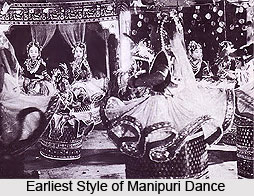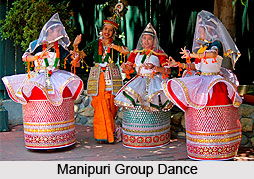 From the 18th Century onwards, the history of Manipuri dance style can be traced accurately. Manipuri dance originates in the north eastern state of Manipur. It is considered as the youngest among the classical Indian dances. Presently it is comparatively free in movements and limited to the literary word and the rigidity of the tala only. It is spontaneous and apparently flows with ease. Manipuri dance is the manifestation of a deep ritualistic tradition combined with vitality. Popular belief says that Lord Krishna and his consort Radha was the creator of Manipuri dance style. Again it was Uma and Lord Shiva who actually repeated this rasa dance style in Manipur. Whatever the myth is the history states that the original form of Manipuri dance is known as the "Lai Haroba".
From the 18th Century onwards, the history of Manipuri dance style can be traced accurately. Manipuri dance originates in the north eastern state of Manipur. It is considered as the youngest among the classical Indian dances. Presently it is comparatively free in movements and limited to the literary word and the rigidity of the tala only. It is spontaneous and apparently flows with ease. Manipuri dance is the manifestation of a deep ritualistic tradition combined with vitality. Popular belief says that Lord Krishna and his consort Radha was the creator of Manipuri dance style. Again it was Uma and Lord Shiva who actually repeated this rasa dance style in Manipur. Whatever the myth is the history states that the original form of Manipuri dance is known as the "Lai Haroba".
Meities in Manipuri Dance
Manipur belongs largely to the valley people who call themselves Meities and trace their antiquity to the Vedic times. Many ritual practices were prevalent in the region earlier. These dances sustained the continuity of such ritual practices. The ritual dances were of sheer devotion and dedication to an unknown divinity. The Meities as a community knew innumerable ritual dances, the most exquisite being the dance of maibas and maibees. They invoke the deity through repetitive but disciplined movement. Couples dance to a theme of two local legends lai Haroba and Khamba Thoibi. They danced to an abstract design that symbolized the tangled serpent. The purpose of worship was to invoke a deity who was formless and is not identifiable with any religion as such.
Impact of Vaishnavism on Manipuri Dance
Though some form of Vaishnavism might have reached there earlier, it was only in the 17th Century Hinduism became the state religion of this valley. The evolution of this form was the result of a mutual interaction between the earlier ritual dances and the Vaishnava Bhakti cult. According to legends, in the 18th Century a king of Manipur named Garib Nivas officially embraced Vaishnavism the ground for it been prepared earlier by Vaishnava missionaries. Sant Dass of Bengal had visited Manipur and that King Kahagemba had built a small temple dedicated to Lord Vishnu. Sant Dass left an immense impact on the people. With the arrival of Vaishnavism appeared a new structure called mandapas, where the Vaishnava devotional songs were sung. Various cults of Vaishnavism like Vishnu swami, Madhavacharya and Rama nandi contributed to the future development of the state religion of Vaishnavism.
 Though the Meities absorbed traditions of Vaishnavism, the older forms and themes were kept intact. This resulted in a repertoire which was divided into two parts. The first consists of the Meities dances namely the Lai Haroba and the Khamba Thoibi, while the second includes the Vaishnavite dances which chiefly present the varieties of rasa dances and the bhangis.
Though the Meities absorbed traditions of Vaishnavism, the older forms and themes were kept intact. This resulted in a repertoire which was divided into two parts. The first consists of the Meities dances namely the Lai Haroba and the Khamba Thoibi, while the second includes the Vaishnavite dances which chiefly present the varieties of rasa dances and the bhangis.
Discovery of Present Form of Manipuri Dance
The present form and repertoire of the dance is attributed to King Bhagyachandra Maharaja. He saw in his dream Lord Krishna and the Gopis performing the divine dance. The rasa dances and the present costumes of Manipuri are attributed to the King`s dream.The manuscripts provide convincing evidence to the unparallel contribution of this King to the modern Manipuri dance. The king wrote a manual on dance called the Govinda Sangita Lila Vilas. It lays down clearly the scope of this dance style.
The Govinda Sangita Lila Vilas follows the tradition of Natyashastra though there are deviations. Tandava and Lasya are defined in this work. Tandava is divided into the chalanam and the gunthanam. Lasya is also divided into simitanga and sphuritanga. The classification of Natya differed from the classification of other texts. It is divided into Rasaka and Rupaka. The word rupaka is apparently a variant of the dasa Rupaka, natika and Prakarana forms of the Natyashastra tradition. The author has divided rasa into many types: the maharasa, malurasa, nityarasa, nirvesarasa or the kunjarasa. Therefore it can be said that Shastric tradition of the Natyashastra and the Puranic tradition of the Srimad Bhagvata have been blended in Manipuri dance. The challis, the bhangis, the Gati bhangsand various types of chalans and sthanakas can be traced to this text.
The theatrical approach, the class refinement that typically classifies Manipuri dance further was hued in the steep color of maturity and style by the eminent poet Rabindranath Tagore who was known as the "pioneer of Manipuri dance and culture".
However, this is not the only manuscript which we find in Manipur. Somewhat later, another king wrote a treatise called the Mridanga sangraha. This work is attributed to Chandrakirti and contains extremely valuable details of playing the particular variety of drum called the khol in Manipuri. The other treatise, Sri Krishna Rasa Sangita Sangraha, by Bhakti Siddhanta, was, perhaps, written earlier than the Mridanga Sangraha. It contains many of the lyrics to which the rasa dances are performed today.



















